Thank you! Your submission has been received!
Oops! Something went wrong while submitting the form.
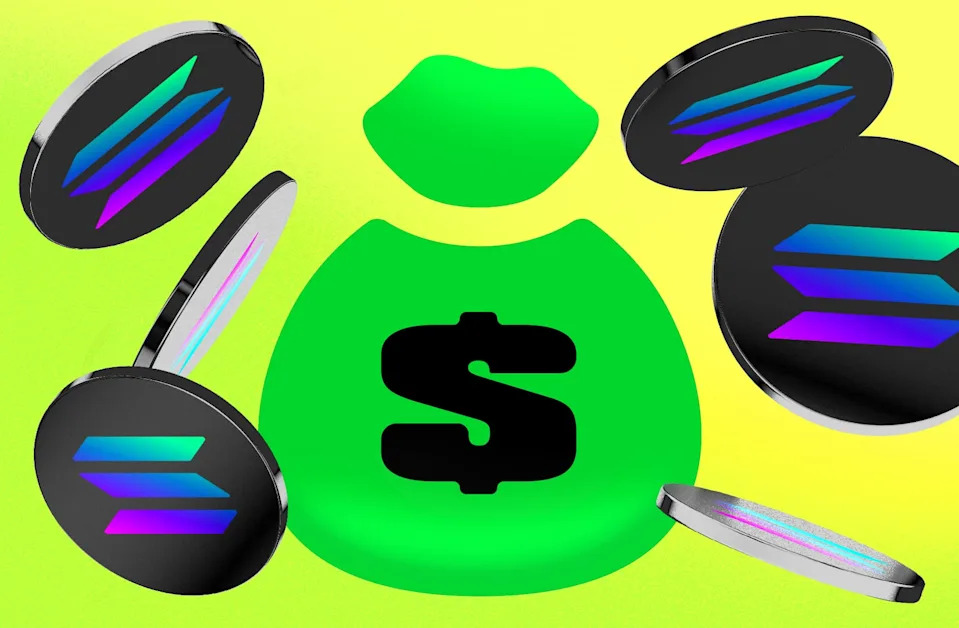
Pump.fun rival Bags hits $1bn in trading volumes
Key Points
- Bags, a new memecoin launchpad on Solana, has gained traction by paying royalties to meme creators and artists, amassing over $1 billion in trading volume in the last 30 days.
- Despite competition from market leaders like Pump.fun and LetsBonk, Bags is the fastest-growing memecoin launchpad on Solana by revenue, having launched in May.
- Bags requires creators to designate royalty recipients, often the original artists or meme creators, distinguishing it from other platforms that allow unrestricted token creation.
- While some creators earn significant royalties, Bags’ top memecoins, BTH and NYAN, have recently dropped by 20% and 32%, respectively, impacting traders.
- The memecoin market is experiencing a resurgence, with a sector value of $77 billion and an 11% increase in the last 30 days, alongside a 45% rise in trading volume.
Summary
Bags, a Solana-based memecoin launchpad launched in May, is carving a niche by paying royalties to meme creators and artists, a strategy that sets it apart from competitors like Pump.fun and LetsBonk. With over $1 billion in trading volume in the past 30 days, Bags is the fastest-growing platform of its kind on Solana by revenue, despite being dwarfed by market leaders. Its model requires creators to specify royalty recipients, often the original artists, addressing ethical concerns around copyright seen in other platforms. However, while some creators earn six-figure payouts, Bags’ top tokens, BTH and NYAN, have plummeted by 20% and 32% in 24 hours, leaving traders with losses. This comes amid a broader memecoin market resurgence, with the sector’s value hitting $77 billion, up 11% in 30 days, and trading volume rising 45%. Solana remains a key blockchain for memecoin activity, seeing a surge in new tokens. Bags’ creator-first approach offers a fresh perspective, but the volatile nature of memecoins continues to pose risks for investors.
yahoo
August 13, 2025
Crypto
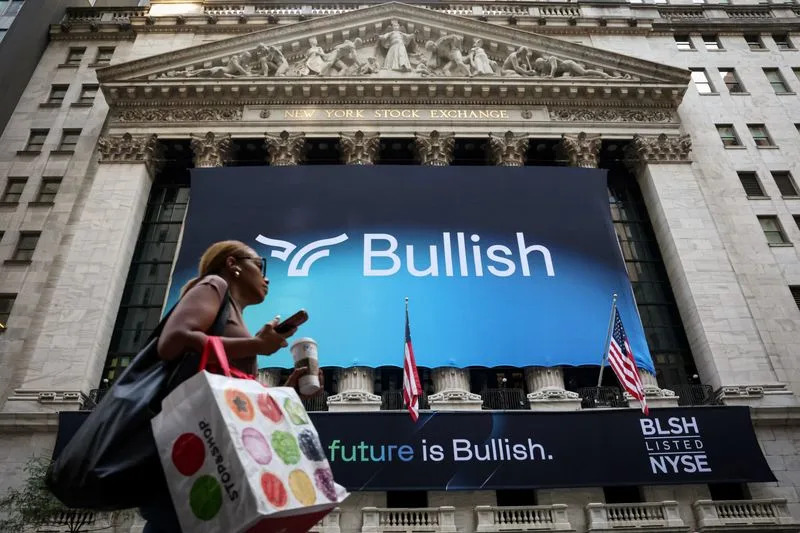
CoinDesk owner Bullish shares indicated to open nearly 62% above IPO price in debut
Key Points
- Bullish, a cryptocurrency exchange operator, is set to open nearly 62% above its IPO price, indicating strong investor confidence in the digital asset sector.
- The IPO, priced at $37 per share, raised $1.11 billion, valuing Bullish at $5.41 billion, with potential to reach $8.77 billion if shares trade at the indicated range of $55 to $60.
- Backed by billionaire Peter Thiel, Bullish's listing is the largest U.S. IPO by a digital assets company this year, following stablecoin giant Circle's successful $1.05 billion IPO.
- A pro-crypto White House, regulatory wins, and corporate adoption have fueled mainstream acceptance, with the crypto market surpassing $4 trillion in value.
- Bullish's success, alongside other crypto firms like Gemini and Grayscale planning IPOs, signals a revived IPO window amid favorable economic conditions.
Summary
Bullish, a cryptocurrency exchange operator backed by billionaire Peter Thiel, is poised to open nearly 62% above its IPO price of $37 per share on the NYSE, potentially valuing the company at $8.77 billion. The IPO raised $1.11 billion, marking the largest U.S. listing by a digital assets firm this year. This follows stablecoin giant Circle's successful $1.05 billion IPO, reflecting growing mainstream adoption of cryptocurrencies, with the sector's market value recently exceeding $4 trillion. Bullish, which acquired CoinDesk in 2023, benefits from a pro-crypto White House, regulatory wins, and corporate treasury adoption, alongside ETF inflows and bitcoin's record highs. The company's debut signals strong investor confidence and boosts prospects for future U.S. listings by other crypto firms like Gemini and Grayscale, who are eyeing public offerings during a revived IPO window driven by robust tech earnings and expectations of easing tariffs and interest rates. J.P. Morgan and Jefferies led the underwriting for Bullish's IPO, underscoring the sector's increasing integration into traditional financial markets.
yahoo
August 13, 2025
Crypto
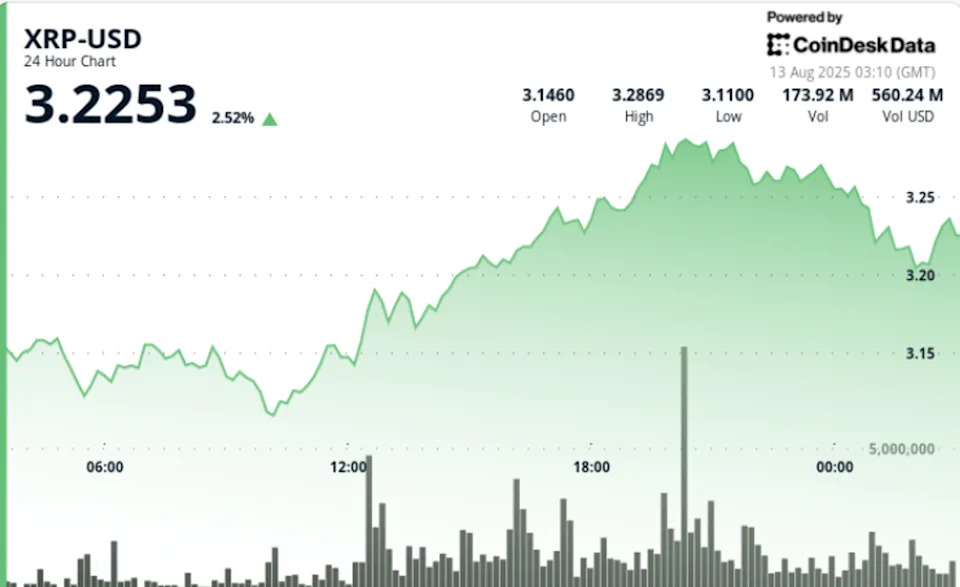
XRP Gains 4% as Ripple-SEC Settlement Spurs Institutional Buying
Key Points
- XRP rises 4% in 24 hours ending August 13, moving from $3.15 to $3.25 with a mid-session peak at $3.30 on high volume exceeding 140M units. **
- Resistance forms at $3.30, while support holds steady at $3.25-$3.26, maintaining a bullish structure despite late-session profit-taking. **
- Legal clarity from Ripple Labs’ settlement with the SEC drives institutional inflows, boosting daily volumes by 208% to $12.4B. **
- Enterprise adoption news, including Blue Origin’s XRP payment integration, further fuels positive market sentiment. **
- Traders are monitoring potential breakouts above $3.30 and the impact of macro factors on price action.
Summary
XRP experienced a 4% gain in the 24-hour period ending August 13, climbing from $3.15 to $3.25, with a mid-session rally pushing the price to $3.30 on trading volume surpassing 140 million units. Resistance at $3.30 and support between $3.25-$3.26 held firm, despite a slight 1% retreat in the final hour due to profit-taking. The price action reflects strong momentum, underpinned by significant news developments. Ripple Labs and the SEC concluded their long-standing litigation by dismissing appeals, providing legal clarity that spurred a 208% surge in daily trading volumes to $12.4 billion as institutional inflows increased. Additionally, enterprise adoption news, such as Blue Origin integrating XRP for payments and the SEC approving Ripple’s enhanced Regulation D exemption, bolstered market sentiment. Technical indicators show a 6% intraday volatility range of $0.20, with volume spikes linked to controlled distribution by institutional desks. Traders are now focused on potential breakouts above $3.30, sustained large-holder inflows, and the broader impact of enterprise news and macroeconomic factors like trade and rate policies on XRP’s spot demand.
yahoo
August 13, 2025
Crypto
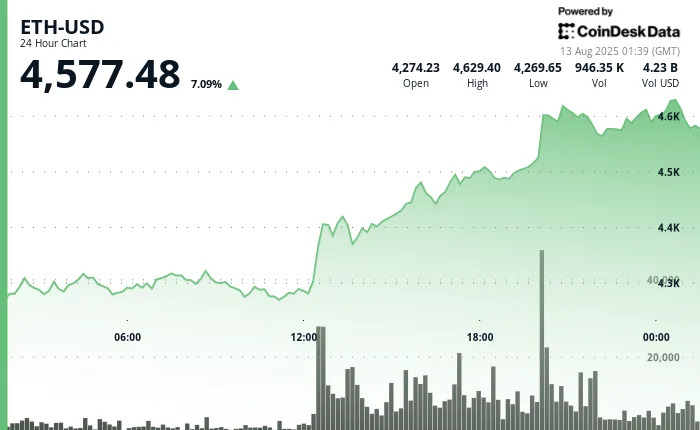
Asia Morning Briefing: Polymarket Bettors Foresee $5K ETH by End of August
Key Points
- ETH Surge: Ethereum (ETH) is trading above $4,600, up 10% in the last 24 hours, fueled by speculation of a September rate cut, with traders eyeing a potential challenge to its all-time high of $4,876.**
- Polymarket Predictions: Bettors on Polymarket are optimistic, predicting ETH could reach $5,000 by the end of August, with a 28% chance of surpassing $5,800.**
- Liquidity Concerns: A CryptoQuant report highlights a growing liquidity drain as ETH is bridged to TRON for USDT, with significant outflows like $7.7 million on Aug. 9, potentially impacting Ethereum’s DeFi activity and fee revenue.**
- Bitcoin Dominance: Bitcoin’s market dominance has dropped from 65% to 59% as traders shift focus to altcoins amid ETH’s rally.**
- Market Dynamics: While short-term bullish momentum persists for ETH, persistent capital flight to cheaper networks like TRON could challenge the sustainability of higher valuations.**
Summary
Ethereum (ETH) is making waves in the crypto market, trading above $4,600 with a 10% surge in the last 24 hours, driven by expectations of a September rate cut. Traders are optimistic, with some eyeing ETH’s all-time high of $4,876, while Polymarket bettors predict a rise to $5,000 or even $5,800 by August’s end. This rally has reduced Bitcoin’s dominance from 65% to 59% as focus shifts to altcoins. However, a CryptoQuant report raises concerns about Ethereum’s liquidity, noting significant outflows to TRON’s USDT ecosystem, including $7.7 million on Aug. 9. Such one-way value flows could undermine Ethereum’s DeFi activity and fee revenue, positioning it as a funding layer for rival networks like TRON. While the current bullish momentum holds, sustained capital flight to cheaper platforms may threaten long-term valuation growth. Meanwhile, Bitcoin remains steady at $119,943, and broader markets like the S&P 500 and Nikkei 225 reflect positive sentiment tied to U.S. inflation data and rate cut expectations.
yahoo
August 13, 2025
Crypto
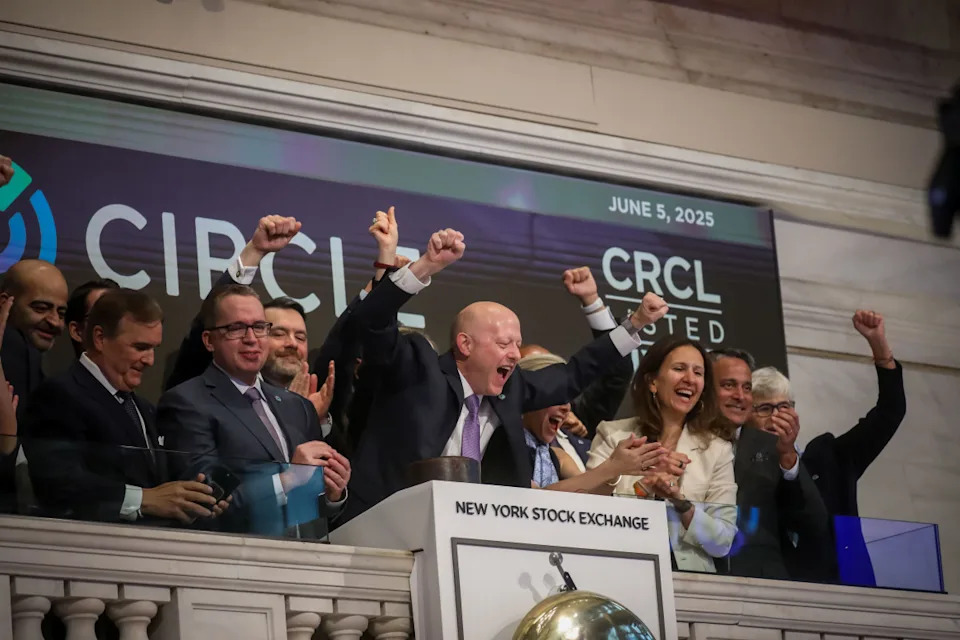
Circle announces new blockchain amid blockbuster earnings
Key Points
- Circle Internet Group (NYSE: CRCL) announced the launch of Arc, a new open layer-1, stablecoin-centric blockchain, on August 12, 2025.
- Arc, an Ethereum Virtual Machine (EVM)-compatible network, uses USDC as its native gas token and is designed for stablecoin payments and capital markets applications.
- Circle reported a 53% year-over-year revenue surge in Q2 2025, totaling $658 million, alongside a 52% increase in adjusted EBITDA to $126 million.
- Despite a net loss of $482 million due to non-cash charges related to its IPO, Circle's stock rose 6.5% in pre-market trading, reaching $172.01.
- The public testnet for Arc is expected to launch this fall, with full integration across Circle’s platform and interoperability with partner blockchains.
Summary
Circle Internet Group (NYSE: CRCL), the company behind the USDC stablecoin, unveiled Arc, a new layer-1 blockchain focused on stablecoin applications, on August 12, 2025. Arc, compatible with the Ethereum Virtual Machine, uses USDC as its native gas token and aims to support enterprise-grade stablecoin payments and capital markets solutions. A public testnet is slated for this fall, with full integration into Circle’s platform and interoperability with numerous partner blockchains. Alongside this launch, Circle reported impressive Q2 2025 earnings, with a 53% year-over-year revenue increase to $658 million and a 52% rise in adjusted EBITDA to $126 million. However, a net loss of $482 million was recorded due to non-cash charges tied to its recent IPO. Following its public debut on the NYSE in June 2025, Circle’s stock surged 6.5% in pre-market trading to $172.01. CEO Jeremy Allaire highlighted the company’s sustained growth and adoption across diverse use cases. With a market cap of $65 billion, Circle holds a significant 24% share of the stablecoin market since its founding in 2013.
yahoo
August 12, 2025
Crypto

Do Kwon to plead guilty to US conspiracy, fraud charges in $40 billion crypto collapse
Key Points
- Do Kwon, co-founder of Terraform Labs, plans to plead guilty to two charges of conspiracy to defraud and wire fraud in a U.S. court.
- Kwon is accused of misleading investors about TerraUSD, a stablecoin, by falsely claiming a computer algorithm restored its value in 2021, when he allegedly manipulated its price.
- The collapse of TerraUSD and Luna in 2022 resulted in an estimated loss of $40 billion for investors.
- Kwon agreed to a $4.55 billion settlement with the SEC in 2024, including an $80 million civil fine and a ban from crypto transactions.
- He has been detained since his extradition from Montenegro and is among several crypto moguls facing federal charges after the 2022 digital token slump.
Summary
Do Kwon, the South Korean cryptocurrency entrepreneur behind Terraform Labs, is set to plead guilty to charges of conspiracy to defraud and wire fraud in a U.S. court. Kwon, who developed the TerraUSD stablecoin and Luna token, is accused of misleading investors by falsely claiming a computer algorithm stabilized TerraUSD’s value in 2021, when he allegedly orchestrated secret purchases to prop up its price. This deception contributed to the $40 billion collapse of both currencies in 2022, impacting retail and institutional investors. Initially pleading not guilty to a nine-count indictment, Kwon now faces sentencing following his plea. In 2024, he settled with the SEC for $4.55 billion, including an $80 million fine and a crypto transaction ban. Detained since his extradition from Montenegro, Kwon is among several crypto figures charged amid the 2022 digital token market crash.
yahoo
August 12, 2025
Crypto

Do Wall Street Analysts Like Coinbase Global Stock?
Key Points
- Coinbase Global, Inc. (COIN), valued at a $79.8 billion market cap, is a leading cryptocurrency exchange offering a comprehensive platform for digital assets.**
- COIN's stock performance has significantly outpaced the S&P 500, with a 61.5% rally over the past 52 weeks and a 25.1% increase year-to-date, compared to SPX’s 20.1% and 8.6% respectively.**
- Recent Q2 results disappointed, with a 16.7% share price drop post-earnings due to a revenue shortfall and an 89.1% decline in adjusted EPS to $0.12, missing analyst estimates.**
- Analyst consensus for COIN is a "Moderate Buy," though sentiment has slightly cooled, with a mean price target of $371.33 indicating a 19.6% premium and a high target of $510 suggesting 64.2% upside.**
- Earnings outlook for the current fiscal year projects a 37.5% EPS decline to $4.75, with a mixed history of beating and missing consensus estimates.**
Summary
Coinbase Global, Inc. (COIN), a leading cryptocurrency exchange with a $79.8 billion market cap, operates a robust platform for digital assets, catering to consumers, institutions, and developers. Over the past 52 weeks, COIN’s stock has surged 61.5%, far outpacing the S&P 500’s 20.1% gain, and year-to-date, it’s up 25.1% against SPX’s 8.6%. However, its Q2 earnings on July 31 disappointed, with revenue of $1.5 billion missing estimates despite a 3.3% year-over-year increase, driven by a drop in transaction revenues. Adjusted EPS plummeted 89.1% to $0.12, triggering a 16.7% share price decline. Analysts project a 37.5% EPS drop for the fiscal year to $4.75, though COIN’s earnings history shows inconsistency. The stock holds a "Moderate Buy" consensus from 31 analysts, with a mean price target of $371.33 (19.6% upside) and a high of $510 (64.2% upside), despite a recent downgrade by Compass Point to "Sell." While COIN has lagged behind the First Trust SkyBridge Crypto ETF’s gains, its long-term potential in the crypto space remains a focal point for investors.
yahoo
August 11, 2025
Crypto
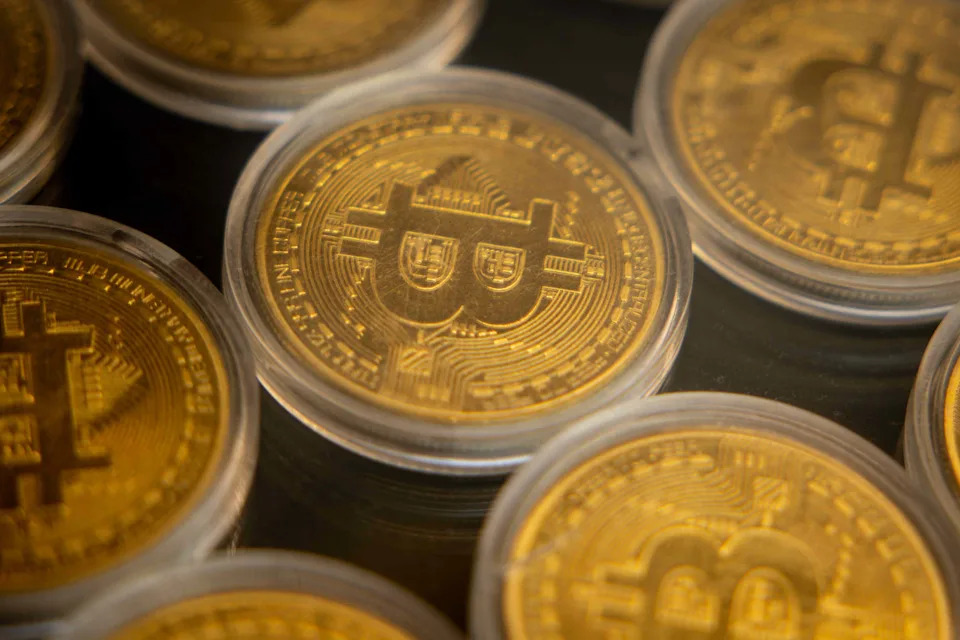
Crypto Stocks Gain as Bitcoin Trades Near Its All-Time High
Key Points
- Bitcoin Surge: Bitcoin traded near its all-time high of over $123,000, with a recent value above $120,000, marking a nearly 30% increase this year.**
- Executive Order Boost: President Trump's executive order last week enabled workers to invest in crypto through 401(k) retirement plans, lifting Bitcoin and related stocks.**
- Crypto Stock Gains: Shares of MicroStrategy (MSTR), Coinbase (COIN), and Robinhood (HOOD) rose, with gains of nearly 3%, over 3%, and almost 2% respectively in premarket trading.**
- Corporate Bitcoin Holder: MicroStrategy, the largest corporate holder of Bitcoin, saw its stock value increase by about a third year-to-date as of Friday's close.**
Summary
Bitcoin started the week trading near its record high of over $123,000, with a recent value above $120,000, reflecting a nearly 30% rise this year. This surge boosted shares of crypto-related companies, including MicroStrategy (MSTR), the largest corporate holder of Bitcoin, Coinbase (COIN), and Robinhood Markets (HOOD), which saw premarket gains of nearly 3%, over 3%, and almost 2% respectively. A significant catalyst for this uptick was President Donald Trump’s executive order last week, which allows workers to invest in cryptocurrencies and alternative assets through their 401(k) retirement plans. Trump emphasized that the order aims to reduce regulatory burdens and litigation risks, urging the Labor Department and SEC to support employers in offering such investments. As of Friday’s close, MicroStrategy’s stock had risen by about a third year-to-date, Coinbase by 21%, and Robinhood reached record highs in 2025. Ether also traded near $4,200, underscoring the broader momentum in the crypto market.
yahoo
August 11, 2025
Crypto
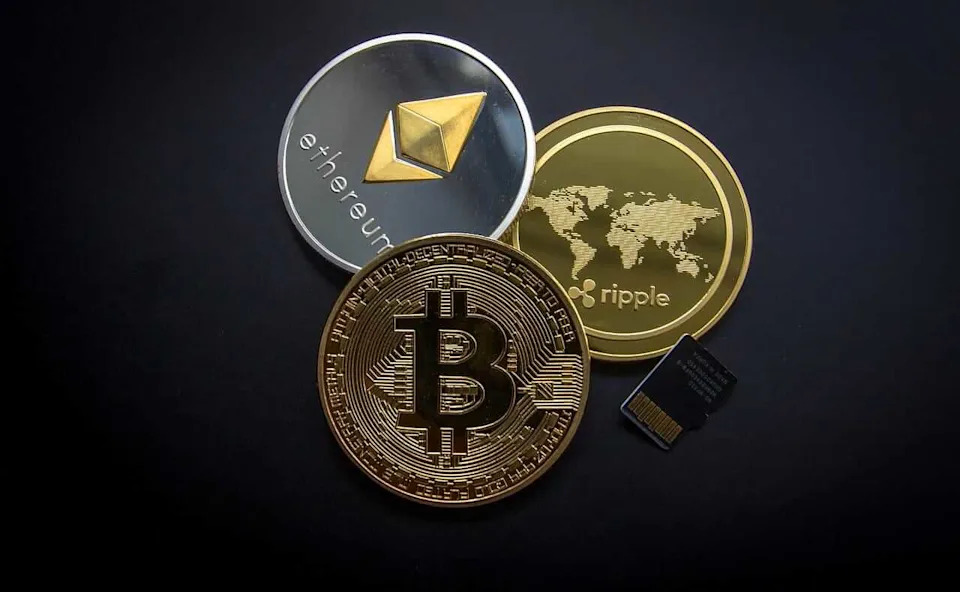
From Theme Parks to Tron: This Company Wants to Be the MicroStrategy of TRX
Key Points
- Tron (TRON), previously SRM Entertainment, has pivoted from a struggling theme park merchandise business to a crypto treasury vehicle focused on accumulating TRX, the native token of Justin Sun’s Tron blockchain.
- The company plans to raise capital through stock, debt, and warrants to invest in TRX and related income-generating strategies, mirroring MicroStrategy’s approach but with a less liquid and more controversial asset.
- Tron’s rebrand includes a reverse merger with Justin Sun’s Tron crypto platform, enabling U.S. trading and potential expansion into digital collectibles tied to theme park IP.
- The stock has delivered a staggering 615% 52-week return, far outpacing the S&P 500, though it carries high risk with negative earnings, a price-sales multiple of 28.34x, and a return on equity of -78.96%.
- There is no analyst coverage for Tron, leaving investors to rely on market sentiment, crypto price trends, and company updates for guidance.
Summary
Tron, formerly SRM Entertainment, has undergone a dramatic transformation from a failing theme park merchandise developer in Winter Park, Florida, to a crypto-focused holding company aiming to amass TRX, the native token of Justin Sun’s Tron blockchain. This pivot, inspired by MicroStrategy’s Bitcoin strategy, involves raising capital through stock, debt, and warrants to invest in TRX and related ventures. A reverse merger with Sun’s Tron platform will facilitate U.S. trading and explore digital collectibles linked to theme park IP. Despite a remarkable 615% 52-week return, far surpassing the S&P 500’s 20% gain, Tron’s financials reveal significant risks, with negative earnings, a high price-sales ratio of 28.34x, and a return on equity of -78.96%. The Tron blockchain’s low-cost, high-throughput capabilities position it well for entertainment and digital projects, but the stock’s speculative nature is heightened by a lack of analyst coverage, forcing investors to rely on market sentiment and crypto trends. With a market cap of $126 million and a recent price near $6.70, Tron’s aggressive rebrand unfolds on a volatile crypto stage, where regulatory shifts and sentiment can drive sharp swings.
yahoo
August 10, 2025
Crypto

1 Reason Why Now Is the Time to Buy Shiba Inu (SHIB)
Key Points
- Shiba Inu (SHIB), the second-largest meme coin with a $7 billion market cap, has lost 43% of its value since the start of 2025, falling out of the top 20 cryptocurrencies.
- Despite the crypto market's overall positive performance in 2025, meme coins like Shiba Inu and Dogecoin (down 36%) have underperformed.
- Shiba Inu has a history of significant bull runs, such as a 370% increase in early 2024 and a 39% rise in November 2024, suggesting potential for recovery.
- Investing in Shiba Inu is highly risky due to its lack of fundamental value, so only invest money you can afford to lose.
- Buying the dip during low interest in meme coins could present a speculative opportunity for gains if another bull run occurs.
Summary
Shiba Inu (SHIB), the second-largest meme coin with a market cap of about $7 billion, has seen a significant decline of 43% in 2025, dropping out of the top 20 cryptocurrencies, while Dogecoin, the top meme coin, fell 36%. This contrasts with the broader crypto market's gains, including Bitcoin's 23% rise and XRP's 44% increase. Despite its current downturn, Shiba Inu has a history of dramatic bull runs, such as a 370% surge in early 2024 and a 39% jump in November 2024, often following Bitcoin's trends. The article suggests that the current low interest in meme coins could be a buying opportunity for risk-tolerant investors. However, it emphasizes Shiba Inu's lack of fundamental value and high risk, advising to only invest disposable funds. While meme coins remain a popular speculative play, the potential for another rally exists, though there's also a chance they could fade over time. Investors are cautioned to keep positions small and approach with caution, as Shiba Inu is more of a fun diversion than a serious investment.
The Motley Fool
August 10, 2025
Crypto

3 Reasons to Buy Bitcoin Before 2026
Key Points
- Improving regulatory clarity in 2025 is making Bitcoin more attractive to mainstream investors, as governments and the Trump administration establish clearer rules and initiatives like the Strategic Bitcoin Reserve.
- Bitcoin's fixed supply of 21 million coins enhances its appeal as "digital gold," offering a credible inflation hedge, especially as its supply growth slows compared to gold.
- Clearer regulations are encouraging institutional investors, such as pension funds and insurance companies, to invest in Bitcoin, boosting market stability and mainstream acceptance.
- A small Bitcoin investment can diversify a portfolio, but it’s wise to keep the stake modest to mitigate risks if skepticism about its value proves correct.
Summary
The article "3 Reasons to Buy Bitcoin Before 2026" highlights Bitcoin's growing appeal as an investment in 2025, driven by evolving market dynamics. It emphasizes three key factors: first, regulatory progress is clarifying the legal framework for cryptocurrencies, with initiatives like the Trump administration’s Strategic Bitcoin Reserve fostering investor confidence. Second, Bitcoin’s fixed supply of 21 million coins positions it as "digital gold," an attractive inflation hedge, especially as its supply growth outpaces gold mining, according to investor Cathie Wood. Third, clearer rules are drawing institutional investors, evidenced by the rapid growth of Bitcoin ETFs like the iShares Bitcoin Trust, which manages $85 billion. Despite skepticism from figures like Warren Buffett, who see no intrinsic value in Bitcoin, the article suggests a small stake in a diversified portfolio could be beneficial. It advises caution, recommending investors limit exposure in case bearish predictions prevail, while noting the potential for significant gains if bullish trends continue. The piece underscores the importance of acting before 2026 to capitalize on these emerging opportunities.
The Motley Fool
August 9, 2025
Crypto

Man who lost 8,000 Bitcoin says he’s done digging
Key Points
- Lost Fortune: James Howells, a computer engineer from Newport, Wales, has abandoned his 12-year quest to recover a hard drive containing 8,000 Bitcoin, now valued at approximately $890 million, accidentally discarded in a landfill in 2013. **
- Council Conflict: Despite multiple attempts to gain access to the landfill, including a multi-million dollar offer to buy the site, Newport City Council has refused cooperation and demanded nearly $149,000 in legal costs from Howells. **
- Legal Defeat: Howells’ legal battles, including a High Court claim for access or $630 million in compensation, were dismissed, with appeals also rejected despite his use of AI to prepare arguments. **
- New Venture: Moving forward, Howells plans to launch Ceiniog Coin (INI), a cryptocurrency backed by the verifiable value of his lost Bitcoin wallet, intended as a store-of-value token. **
Summary
James Howells, a computer engineer from Newport, Wales, has ended his 12-year struggle to recover a hard drive with 8,000 Bitcoin, now worth around $890 million, lost in a landfill in 2013 after being accidentally discarded by his ex-girlfriend. Despite persistent efforts to search the site, including a multi-million dollar offer to purchase it, Newport City Council has denied access and demanded nearly $149,000 in legal fees from failed court attempts. Howells’ legal claims, including a High Court bid for access or $630 million in compensation, were dismissed, and his appeals, prepared with AI assistance, were also rejected. Accusing the council of “financial coercion” for tying his offer to unrelated debts, Howells has decided to move on. Instead of continuing the search, he is launching Ceiniog Coin (INI), a new cryptocurrency backed by the publicly verifiable value of his lost Bitcoin wallet, positioning it as a store-of-value token. This shift marks the end of a costly and frustrating chapter for Howells, as reported by TheStreet on August 8, 2025.
yahoo
August 9, 2025
Crypto

Trump crypto firm plans launch of public company that will hold family token
Key Points
- Trump Family's Crypto Venture: World Liberty Financial, a Trump family business, plans to launch a publicly traded crypto treasury company holding its proprietary token WLFI and cash, aiming to raise $1.5 billion.**
- Leadership Roles: Eric Trump and Donald Trump Jr. are proposed to serve on the board of the new treasury company.**
- Crypto Empire Growth: This initiative adds to the Trump family's expanding crypto portfolio, which includes the WLFI token ($550 million in sales) and a stablecoin, USD1.**
- Industry Trend: The plan aligns with the rising trend of digital asset treasury companies, inspired by Michael Saylor’s MicroStrategy, now Strategy, which holds over $72 billion in Bitcoin.**
- Market Risks: Despite the boom, some investors caution that the crypto treasury trend may be a fad, posing risks of collapse as the current crypto surge wanes.**
Summary
World Liberty Financial, a Trump family business, is set to launch a publicly traded crypto treasury company, combining its WLFI token and cash, with a goal to raise $1.5 billion, according to investor details reported by Fortune. Eric Trump and Donald Trump Jr. are slated to join the board of this NASDAQ-listed shell firm. This move expands the Trump family’s crypto ventures, which already include the successful WLFI token ($550 million in sales) and a stablecoin, USD1. The plan mirrors a growing trend of digital asset treasury companies, pioneered by Michael Saylor’s Strategy (formerly MicroStrategy), which holds over $72 billion in Bitcoin. Similar firms now exist for Ethereum and other cryptocurrencies, while Trump Media recently acquired $2 billion in Bitcoin. Advocates argue these companies provide traditional investors access to digital assets, but critics warn of potential collapse as the crypto boom fades. The Trump family’s involvement in blockchain extends beyond World Liberty, with personal memecoins and a Bitcoin mining venture backed by Eric and Donald Jr. Spokespersons for the family and World Liberty declined to comment on the treasury company plans.
Leo Schwartz
August 9, 2025
Crypto

Ethereum pops above $4,000 after Ripple, Chainlink lead altcoin rally early Friday
Key Points
- Ethereum (ETH-USD) surged past $4,000 early Friday, nearing its highest level of the year, driven by a broader altcoin rally.
- Ripple's XRP (XRP-USD) rose by up to 8% following the announcement of Ripple acquiring Rail, a stablecoin payments platform, for $200 million.
- Chainlink's LINK (LINK-USD) increased by up to 11% after launching the Chainlink Reserve to accumulate LINK tokens from institutional and on-chain fees.
- President Trump signed an executive order promoting alternative investments like cryptocurrency in retirement accounts, alongside the GENIUS Act regulating stablecoins.
- Bitcoin (BTC-USD) traded near $116,500 early Friday, reflecting a warming stance in Washington toward cryptocurrency adoption and regulation.
Summary
Ethereum (ETH-USD) soared past $4,000 early Friday, joining a robust altcoin rally led by Ripple's XRP (XRP-USD) and Chainlink's LINK (LINK-USD), which gained up to 8% and 11%, respectively. Ripple's surge followed its $200 million acquisition of Rail, a stablecoin payments platform, aimed at enhancing global payment solutions. Chainlink announced the launch of its Chainlink Reserve to bolster LINK token holdings through institutional and on-chain fees. Meanwhile, Bitcoin (BTC-USD) hovered near $116,500, buoyed by President Trump’s executive order promoting cryptocurrencies in retirement accounts and the signing of the GENIUS Act for stablecoin regulation. Other legislative efforts, like the Clarity and Anti-CBDC Acts, signal a thawing of Washington's stance on crypto. This comes amid growing corporate adoption of bitcoin treasury strategies and successful IPOs like Circle’s, highlighting the increasing mainstream acceptance of digital assets.
yahoo
August 8, 2025
Crypto

Ether, Dogecoin Rally as XRP Soars 12% in Altcoin-Led Crypto Surge
Key Points
- Global risk appetite increased on Friday, boosting crypto, equities, and gold futures, while oil prices faced a significant weekly decline of over 4%.
- Crypto market cap rose 3% to $3.76 trillion, with strong gains in altcoins like Ether (+7.3%), XRP (+12%), Solana (+4.7%), and Dogecoin (+8.8%), though Bitcoin only rose 1.9%.
- Bitcoin demand shows signs of cooling, with BTC trapped between $112,000 support and $120,000 resistance, alongside reduced ETF inflows and network activity.
- Oil prices declined due to rising US inventories and weaker Chinese import data, marking the steepest weekly drop since June.
- Asian markets saw gains, with Japan’s Nikkei-225 up 2.3% following eased US-Japan trade tensions, while crypto options markets indicate heavier hedging for BTC below $100,000.
Summary
Global risk appetite surged on Friday, driving gains in cryptocurrencies, equities, and gold futures, while oil prices headed for their steepest weekly decline since June, dropping over 4% due to rising US inventories and weak Chinese import data. The total crypto market cap increased by 3% to $3.76 trillion, with altcoins like Ether (+7.3%), XRP (+12%), Solana (+4.7%), and Dogecoin (+8.8%) leading the rally, though Bitcoin lagged with a modest 1.9% rise to $116,781. Bitcoin demand appears to be cooling, with market sentiment shifting from euphoria to caution, evidenced by a 25% drop in spot Bitcoin ETF inflows, reduced network activity, and lower transaction fees. BTC remains stuck between $112,000 support and $120,000 resistance, while options markets show increased hedging below $100,000. In broader markets, Asian indices like the MSCI Asia Pacific Index (+0.5%) and Japan’s Nikkei-225 (+2.3%) gained, buoyed by eased US-Japan trade tensions. Analysts note the crypto rebound aligns with stock market optimism, but warn of potential stagnation for Bitcoin amid a summer lull.
yahoo
August 8, 2025
Crypto
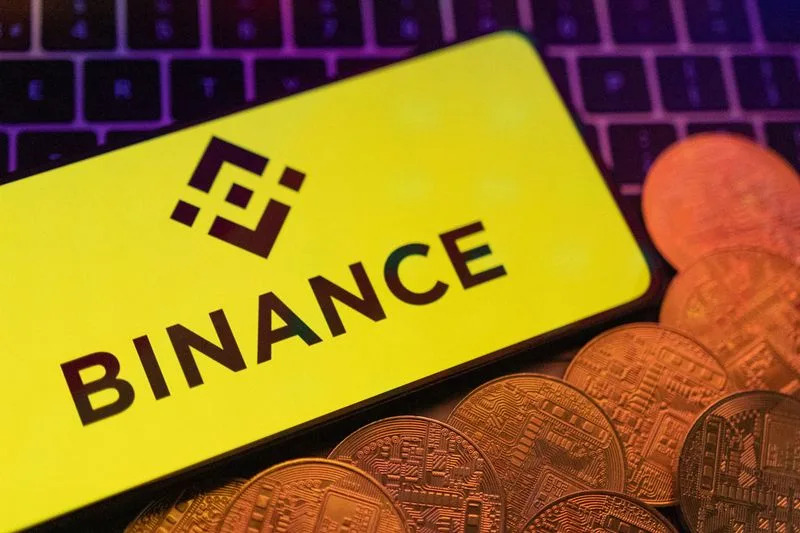
Binance teams up with BBVA to let customers keep assets off exchange, FT reports
Key Points
- Binance Collaboration: Binance, the world's largest crypto exchange, is partnering with Spanish bank BBVA to enable customers to store their assets off the exchange, as reported by the Financial Times.**
- BBVA as Custodian: BBVA is among a select few independent custodians working with Binance, according to sources familiar with the matter.**
- Regulatory Challenges: This development occurs amid increased global regulatory scrutiny on Binance, including a $4.3 billion fine from U.S. authorities in February for violating anti-money laundering and sanctions laws.**
- Industry Context: The move aims to bolster investor confidence in fund safety following the 2022 collapse of FTX, a major crypto exchange.**
Summary
Binance, the leading global cryptocurrency exchange, is collaborating with Spanish bank BBVA to allow customers to store their assets outside the exchange, according to a Financial Times report. BBVA is one of a limited number of independent custodians supporting Binance in this initiative, as confirmed by sources familiar with the arrangement. This step comes at a time when Binance is under intense regulatory pressure worldwide, highlighted by a $4.3 billion penalty imposed by U.S. authorities in February for breaches in anti-money laundering and sanctions laws. Additionally, Binance’s founder, Changpeng Zhao, received a four-month prison sentence related to these lapses. The partnership with BBVA is seen as an effort to enhance investor trust in the safety of funds, especially in the aftermath of the 2022 FTX collapse, which shook the crypto industry. Neither BBVA nor Binance provided immediate comments to Reuters on the report. This development reflects broader trends in the cryptocurrency sector, where exchanges are seeking to address security concerns and regulatory compliance to maintain credibility and protect user assets amidst ongoing challenges.
yahoo
August 8, 2025
Crypto